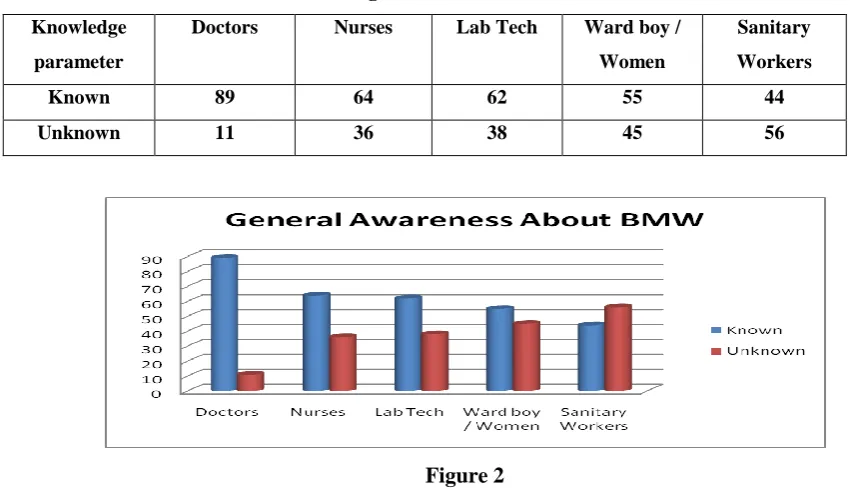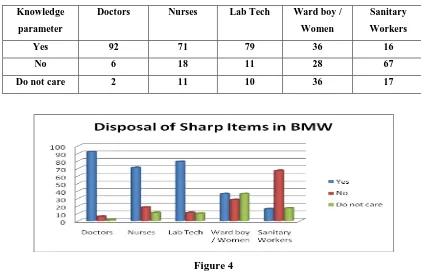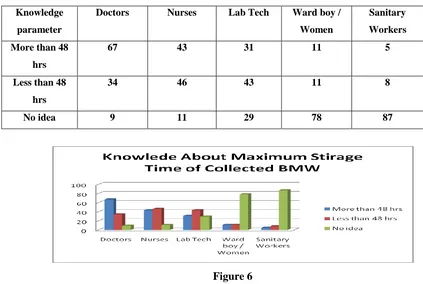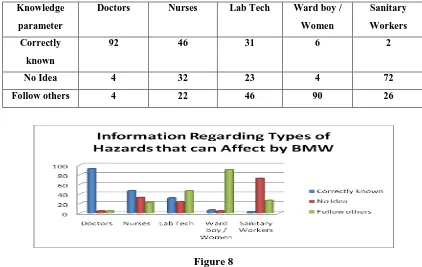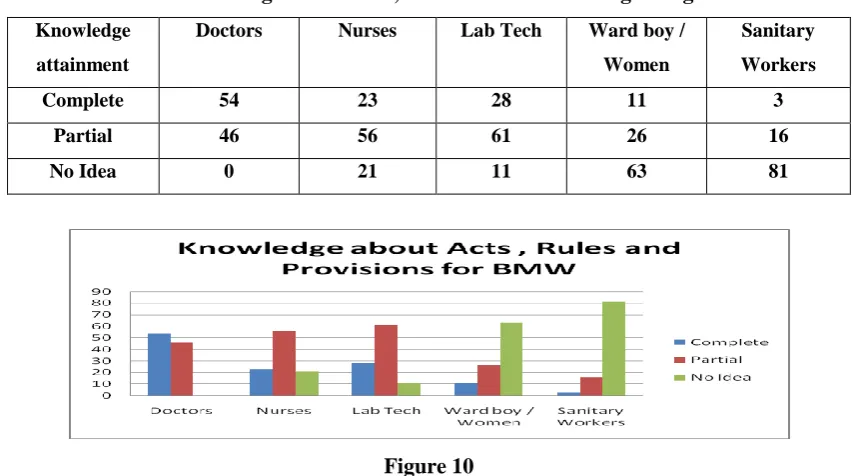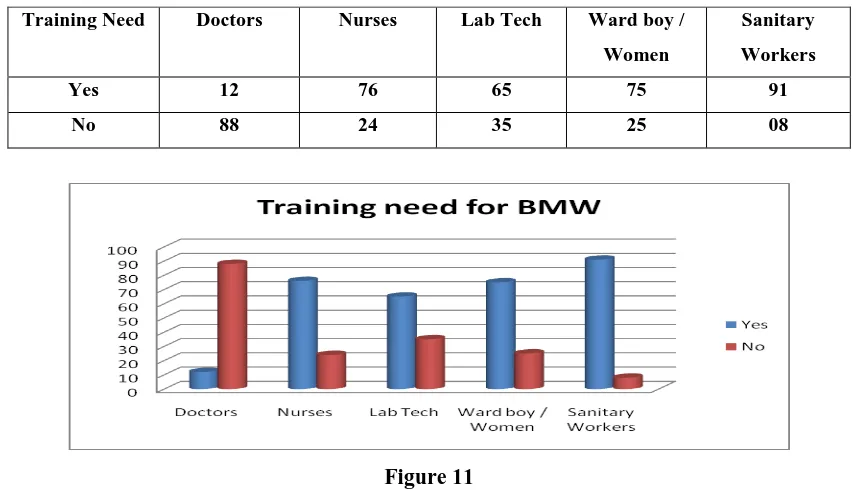BIO MEDICAL WASTE AWARENESS IN HEALTH
CARE PROFESSIONALS: CASE STUDY OF PRIVATE
HOSPITALS & NURSING HOMES IN RANCHI
Dr. Umesh Kumar
1,
Dr. Ramesh Kumar
2 1Principal, Govt. Women’s Polytechnic, Ranchi (India)
2
Professor, Computer Science & Engineering, Bhilai Institute of Technology, Bhilai, Durg (India)
ABSTRACT
There are multiple wastes generated in the world. Few are deadly and needs awareness of utmost level. The Bio
Medical Waste is one among such. The contamination and affects are deadly for these. The select group of
persons is more prone to come in contact. These contact group needs to be highly alert and aware about the
deadly contamination. The study reveals that the best know how group i.e. Doctors level of awareness is high
but need careful handling from them also. The least aware group are Ward boys and Sanitary group persons
who are more likely to get contamination. Extensive need of making them knowledgeable is need of hour.
Keywords: Biomedical Waste, Hazards, Awareness, Medicos, Health Professionals,
I. INTRODUCTION
Waste is a generic term which is outcome of materials , things and products which when used or stored lose
their usefulness and become unwanted thing is termed as waste. Waste is a major environmental issue
everywhere since the evolution of mankind and development in industrial and social spheres. Wastes are created
at home, school and other public places, industries etc. The wastes produced only vary as per source and place
they are generated. The major question is not generation of waste but is where and how it ends up. Every person
is responsible for waste generation; some people are environmentally conscious and generate less waste. If
thought in terms of countries, some countries create less waste and manage elongation of lifecycle by recycle,
reuse and other techniques. The game of passing bug is also very well evident from have ones to have not ones
in name of technology transfer and help. Best way of handling waste is to limit its generation.
The age old generation of typical waste coming out of Hospitals and Nursing Homes has to be categories as
different types. These are Hazardous and deadly in nature beyond any ones expectations. The select group is
likely being affected from these most deadly contaminations. A study for awareness about the different aspects
of such is need of hour for making associated persons aware about their getting affected and getting prey to such
situation.
The situation obtained from the survey shows the level of awareness as alarming in the lower and section of
II. TYPES OF WASTES IN GENERAL
Different types of wastes can be classified as:-
Municipal Waste : These are wastes or garbage from households, schools, offices, market places, restaurants,
other public places which can be everyday items like food debris, used plastic bags, soda cans , plastic bottles,
broken furniture, grass clippings, product packaging, broken home appliances and waste clothing. The
composition in percentage and existence of Municipal wastes are as
Figure 1
2.1 Agricultural Waste
These are waste generated by agricultural activities. It includes waste from horticulture, fruit growing, seed
growing, livestock breeding, market gardens ,seedling nurseries, etc. Empty pesticide containers, old silage
wrap, out dated chemicals & medicines and wormers, used tires, surplus milk, cocoa pods, corn husks etc are
classified in it.
2.2 Industrial Wastes
Industrial revolution and industrial growth has led to typical types of waste generations. The wastes due to this
are categorized in it.
Civil Constructions & Demolition Wastes : Wastes generated out of the rest out materials of the building
constructions or the waste materials left out from the debris of demolition comes under this category.
Electronic Wastes: Waste arising out of electronic and electrical devices which are often called waste,
e-scrap, or waste electrical and electronic equipment (WEEE). Most of the waste materials contains hazardous
lead, mercury, cadmium, and brominated flame retardants which are harmful to living beings and equally to
environment.
III. BIOMEDICAL WASTE & ITS TYPES
I
t is the waste coming from health care facilities, such as hospitals, clinics, surgical theaters, veterinary hospitalsand labs. Items in this group include surgical items, pharmaceuticals, blood, body parts, wound dressing
materials, needles and syringes. These can be further classified as hazardous waste rather than general waste.
Definition of Bio medical waste as per “Bio-Medical Waste (Management & Handling) Rules, 1998” is
beings or animals or in research activities pertaining thereto or in the production or testing of biological, and
including categories mentioned in Schedule I; [1] It has been categorized in 10 categories namely
Cat 1 Human Anatomical Waste includes human tissues, organs, body parts.
Cat 2 Animal Waste : animal tissues, organs, body parts carcasses, bleeding parts, fluid, blood and
experimental animals used in research, waste generated by veterinary hospitals colleges, discharge
from hospitals, animal.
Cat 3 Microbiology & Biotechnology Waste :wastes from laboratory cultures, stocks or specimens of
micro-organisms live or attenuated vaccines, human and animal cell culture used in research and
infectious agents from research and industrial laboratories, wastes from production of biologicals,
toxins, dishes and devices used for transfer of cultures.
Cat 4 Waste sharps :needles, syringes, scalpels, blades, glass, etc. that may cause puncture and cuts. This
includes both used and unused sharps.
Cat 5 Discarded Medicines and Cytotoxic drugs :wastes comprising of outdated, contaminated and
discarded medicines.
Cat 6 Solid Waste :Items contaminated with blood, and body fluids including cotton dressings, soiled
plaster casts, lines, beddings, other material contaminated with blood.
Cat 7 Solid Waste “wastes generated from disposable items other than the waste shaprs such as tubings,
catheters, intravenous sets etc..
Cat 8 Liquid Waste : waste generated from laboratory and washing, cleaning, house-keeping and
disinfecting activities.
Cat 9 Incineration Ash : ash from incineration of any bio-medical waste.
Cat 10 Chemical Waste (chemicals used in production of biologicals, chemicals used in disinfection, as
insecticides, etc.. [1]
Out of these categories the cat 3, 4 and 5 are deadly ones and needs utmost care and awareness by the handlers.
On an average 1.45 kg BMW is generated per patient per day in Indian hospitals compared to 4.5 kg in
developed countries. As per western figures, approximately 15- 20% of this total BMW waste is hazardous. The
percentage in case of India would be much higher because proper waste segregation and waste disposal
methods either does not exist or not practiced. [2]
IV. PRESENT STUDY ON AWARENESS & DISCUSSION
A questioners was developed to know the awareness level of Doctors, Para medical staffs and other staff
members who are involved in the BMW. A cross sectional study was conducted in ten leading private hospital
and nursing homes in Ranchi in Jharkhand capital. About 100 doctors, 100 Nurse,100 Lab Technicians, 100
Ward Boys / Women and 100 Sanitary Workers engaged in Hospitals and clinics were given the designed
questioners and collected.
The study was conducted during May – June of 2015. Leading 10 Hospitals and Nursing Homes having bed
method. The questionnaire was such framed that it had questions regarding general awareness, biomedical
wastes(BMWs), knowledge regarding biomedical hazard, its representation by symbol, the storage time after
collection, its disposal techniques, collection details regarding container for needle syringe, typical
internationally accepted colour coding of bags used for storage and disposal, details about hazards due to
exposure of BMWs. Statistical methods were applied to get graphical representations of correct responses was
assessed and analyzed. The study group was after the collection of data provided with proper information about
the correct handling of these BMWs. Techniques of proper handling for health education on safe biomedical
waste handling was provided.
The data obtained from the samples were as follows:
Table 1 Knowledge about General Awareness of BMW
Knowledge
parameter
Doctors Nurses Lab Tech Ward boy /
Women
Sanitary
Workers
Known 89 64 62 55 44
Unknown 11 36 38 45 56
Figure 2
Analysis shows that he known group of Doctors is very high. Level of Sanitary workers is below average and
needs more alertness.
Table 2 Knowledge about Bio Medical Symbols
Knowledge
parameter
Doctors Nurses Lab Tech Ward boy /
Women
Sanitary
Workers
Yes 92 83 88 72 38
Figure 3
As usual the elite group of Doctors is high. The worst effected group of Sanitary workers is least knowledgeable
in this case also.
Table 3 Knowledge about Disposal Techniques of sharp items among BMW
Knowledge
parameter
Doctors Nurses Lab Tech Ward boy /
Women
Sanitary
Workers
Yes 92 71 79 36 16
No 6 18 11 28 67
Do not care 2 11 10 36 17
Figure 4
The disposable technique among sanitary group is high. The group of ward boys and nurses and Lab
Technicians who are responsible for segregation and disposal are fairly knowledgeable.. Doctors are the masters
in this case also.
Table 4 Knowledge about Disposal of Hazardous and contaminated items of BMW
Knowledge
parameter
Doctors Nurses Lab Tech Ward boy /
Women
Sanitary
Workers
Sensitive 87 76 60 34 21
Careless 10 18 29 56 53
Figure 5
The pattern is similar to the above discussion.
Table 5 Knowledge about Maximum Storage Time of collected BMW
Knowledge
parameter
Doctors Nurses Lab Tech Ward boy /
Women
Sanitary
Workers
More than 48
hrs
67 43 31 11 5
Less than 48
hrs
34 46 43 11 8
No idea 9 11 29 78 87
Figure 6
The analysis shows the very high ignorance in the Lab ward and Sanitary group. The condition of Lab
Technician is also not good.
Table 6 Knowledge about Disposal Methods of collected BMW
Knowledge
parameter
Doctors Nurses Lab Tech Ward boy /
Women
Sanitary
Workers
Correctly
known
38 22 18 8 2
No Idea 9 16 12 12 11
Figure 7
The situation is alarming in this case. The disposal methods scenario of knowledgeable to less ones is in
increasing order only. The aspect requires a high training need.
Table 7 Knowledge about Types of Hazards that can affect exposer of BMW
Knowledge
parameter
Doctors Nurses Lab Tech Ward boy /
Women
Sanitary
Workers
Correctly
known
92 46 31 6 2
No Idea 4 32 23 4 72
Follow others 4 22 46 90 26
Figure 8
In this case the Doctors are the only group who have adequate know how. The group of Nurses is less known
whereas the group of Ward Boy and Sanitary workers is almost non knowledgeable. The Lab Technicians are
also shaky group.
Table 8 Knowledge about Types of Colour Codes for bags of BMW
Knowledge
parameter
Doctors Nurses Lab Tech Ward boy /
Women
Sanitary
Workers
Correctly
known
67 81 79 67 41
Figure 09
The pattern shows the group responsible for handling is knowledgeable. The need for training requirement is
high in the lesser qualified vernable group of sanitary workers.
Table 8 Knowledge about Acts , Rules & Provisions regarding BMW
Knowledge
attainment
Doctors Nurses Lab Tech Ward boy /
Women
Sanitary
Workers
Complete 54 23 28 11 3
Partial 46 56 61 26 16
No Idea 0 21 11 63 81
Figure 10
The situation of ignorance about the Knowledgeable of Acts, Rules in the elite group is also low. There is need
for inclusion in training and extensive inclusion in course curricula of the course. The distribution of leaflets and
dos and don’ts among the concerned can help to increase the level of knowledge.
Table 9 Information about Diseases spread by BMW
Diseases Doctors Nurses Lab Tech Ward boy /
Women
Sanitary
Workers
HIV 89 76 65 45 11
Hep B 87 68 59 23 13
Hep C 89 69 61 32 14
TB 91 91 73 21 65
Tetanus 99 92 81 34 54
Syphilis 78 65 75 41 32
DM 81 43 83 21 21
RHD 69 68 45 23 12
Others 81 66 71 31 14
Figure 10
The result is as per knowledge and need only. The training need for lower group will make them enable to go
for work in protective manner. The affect of handling will not see the group but will affect the persons who
mostly come in contact. The group of Lab Ward boys and Sanitary persons need effective training in this aspect.
Table 10 Need of Training for awareness of BMW
Training Need Doctors Nurses Lab Tech Ward boy /
Women
Sanitary
Workers
Yes 12 76 65 75 91
No 88 24 35 25 08
Figure 11
The need for training is in line of the analysis of the previous sections. The level of need for training among
Doctors perhaps is as refresher courses. IN case of Nurses and Lab Technicians is need and to keep them aware.
The sanitary workers group is a volatile group and its training will be difficult task. The select group is engaged
as per need and strata are varied one.
The study and discussion of the various group finding show that the group as per their level of education and
training. The best group is of Doctors who are highly educated but are less prone to getting affected with this
type of deadly waste. The group of Nurses and Lab Technicians who are handling the patients of having
affection of contaminable disease are prone to get affected during the acts of vaccination and or actions when
the wastes are getting generated. Here the multiple injection case for getting other patients affecting can also be
the case. In case of Lab Ward boys / women and Sanitary workers thee are the least educated persons and have
very less affordability for bearing the medical expenses if they get affected are the most vernable persons .
These groups have very less knowhow and are groups who for want of employment keep changing their place of
working also.
The situation of awareness is poor to worse and need extensive training among classes of most vernable to least
vernable ones. Extensive awareness and training camps are required.
REFERENCES
[1]. Bio-Medical Waste (Management & Handling) Rules, 1998
[2]. Lal S. Text book of community medicine. 1st ed. New Delhi. CBS publishers: 2007: 658-64
[3]. Manoj Bansal, et al Biomedical waste management: awareness and practices in a district of Madhya
Pradesh. National Journal of Community Medicine 2011; 2(3):452-456
[4]. Suwarna Madhukumar, et al Study-about-awareness-and-practices about health-care
aste-management-among hospital staff-in-a-medical-college-hospital-Bangalore. IJBMS. 2013;3(6).
[5]. Satish Sinha, Bio Medical Waste Management: Toxic Links available on net
[6]. Pruss, Cirouit E et al, Safe management of wastes from health-care activities,WHO,1999.

